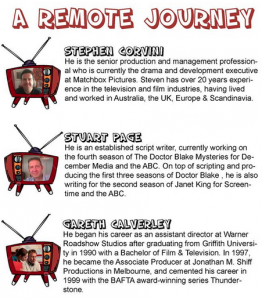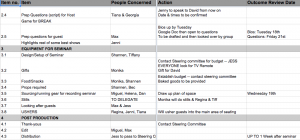The day of our seminar had finally arrived and from the get go i feel as though everyone felt very calm cool and collected as we made our way to our first meeting of the day at 1:30 in building 80 level 7. After running through the call sheet that Jess made the previous week, Miguel, Helena and I split off from the crew to go and organise the gear that we had ordered for our seminar. We had a 4 camera setup, similar to that of last weeks however we have added another DSLR to cover specifically the still images which was operated by Regina Lee. I was tasked with operating the Canon 650D, which we had decided would cover the close up shots of our guests: Stephen Corvini, Stuart Page and Gareth Calverley (see below). After several hours of setting up our stage, which included several trips back and forth between building 80 and building 7 for furniture, the time had come to introduce our guests to the audience… It had begun… After perhaps 30 mins everything was running perfectly to plan with healthy discussion amongst the panel members and host David Delminico, then suddenly the alarm sounded and building 80 was evacuated for 25 minutes. After returning back into the seminar and everyone slightly in disbelief we managed to complete our Tv seminar with only a few extra minutes on the clock, so all in all I was extremely pleased with how we worked together as a team, (we also had matching crew shirts, go us) but also as a crew on a more professional level, that we had managed to bring in these fully fledged Tv industry proffesionals to come in and talk to us for free about how to move through the swings and sways of such an interesting industry was just astounding, was very proud of us. 

Week 5 Media 6 Seminar Series
Today’s seminar is about Social Media, hosted by the charismatic personality, Ned Dorman. The seminar was both very strong in content as well as its technical aspects of production. After talking to a few of the crew memebers, Miguel Camacho and I were allowed to come into the seminar room 45 minutes prior to the start of the presentation. We watched as the camera crew set up positions in the room. Their setup included 2 HD video cameras (XL70) and a DSLR camera (650D), the first video cam was placed directly stage right and up 3 rows, the second was at the very back in the centre. The DSLR was used to gather close ups and stills from all sorts of angles around the room. The seminar ran rather ‘rigidly’ in structure that is to say they addressed each interviewee separately, i.e. 20 mins with each guest then they would leave stage, this was perhaps the only thing in their seminar which i could have viewed in a critical manner. I believe a much more effective procedure could have been to have all three guests be on stage for the same amount of time answering similar questions in a ‘discussion’ type setup, it just feels a less awkward way to present the guests… that is solely my opinion though. The aforementioned camera setup would also work best in a setting where the guest speakers were interacting with eachother as opposed to the interviewee to interviewer setup. I will talk to Max and Jess in regards to this matter, only one more week to go :/
Week 3 Media 6 Seminar Series
After attending our first group meeting today regarding the Seminar Series, I feel very confident that our group is going to excel in most if not all aspects of our TV Seminar in week 6. Our team leader/coordinator is Jess Junor, our first hurdle that we overcame today was allocating the various tasks and crew roles for our Seminar in week 6. Attached below is a screenshot of the excel spreadsheet that we linked to our google docs page. Personally, I have always enjoyed working with the technical aspects of film/tv production, such as lighting, audio, graphics and especially camera. My current goal is to work in the tv industry as a cinematographer/D.O.P. so naturally I presented my interests in pursuing Camera Operator as my main crew role for the seminar. Along with Helena Polley and Miguel Camacho I hope to create the perfect camera setup and hence the most efficient yet interesting way to document our guest speakers’ advice. 
Major Project + Critical Statement
Noticing: A Look Beyond the Frame.
http://www.themediastudents.net/im1/projects/noticing
by Daniel Strangward, Romy Cohen and Ned Dorman.
Critical Statement/Essay below:
https://www.mediafactory.org.au/daniel-strangward/files/2014/06/KFilm-Essay-2fj7wn9.pdf
Noticing: A Look Beyond the Frame
Participation For IM1 – Self Assessment
What did you do well?
I can safely say that I was actively engaging with class discussions, especially those that pertained to the readings. From the start of the year I printed out all the set reading materials for the year and then filed them under a weekly system in my study, this perhaps is the best bit of advice i could give to anyone who struggles with procrastination and lack of incentive. Having a physical copy of the material at an easily accessible place led to myself being completely up to date and actually having valuable input during discussion in class and especially in my blog and general online persona.
What have you learnt to do better?
I have learnt how to approach a new piece of software (korsakov and now premiere). Often when told to use an unknown software program I freeze up and the whole process just seems out of my reach. But through the use of online tutorials this was SO much easier to approach, it is key to read up on what the software is actually used for first and then to go to youtube and search for a several step/stage tutorial on the basics.
What could you have learnt to do better?
I could have definitely improved on my general organisation of my blog and k-films. Often, I found myself searching for ages trying to find a document or post from my blog/hard drive because I didn’t use tags and links and i didn’t put my korsakov assets into specifically titled and layered folders.
Overall Average Mark: P+
Sketch Film
http://www.themediastudents.net/im1/2014/daniel.strangward/
Film Essay – Integrated Media 1
Integrated Media One 2014 – Assessment Task 2 of 4 – Film Essay
Daniel Strangward S3429300
The Interactive Film ‘Scatology,’ (B. Spink, J. Khoo, C. Evani, and S. Ismail 2013)[1], uses a variety of seemingly simple patterns and links to create a rather confronting piece on the ugly habits we humans form. The work often adopts a light tone when listing our most disgusting behaviours and hence the pretty imagery is strongly contrasted with the discussed themes, making the voice-overs all the more prominent.
‘Scat’ is comprised of clips from mostly public places that run for approxiamately 6-10 seconds and have an audio channel that contains a voice-over. These voice-overs have more than 1 ‘life’ and can be heard on multiple of the video clips. For e.g. the voice-over of the man who “gets in fights on trains” and who’s favourite word was “cunt,” is played both in the clip of the café and the clip inside the church. One obvious pattern that is apparent in ‘Scat’ is the 2 thumbnails below the main viewing frame are shaped in the male and or female signs. This allows us to obviously take the path of hearing a male’s worst habits or hearing a female’s darkest practises.
The film is very aesthetically pleasing to the user/viewer because of its simple and somewhat symmetrical setup or ‘interface.’ ‘Scat’ is comprised of 1 larger screen (frame) and 2 smaller thumbnails directly below it. The thumbnails have been cleverly worked to show the preview of the next clip however it has been cropped into the shape of either a man or a woman. Each clip appears to have more than 1 ‘life’ (Korsakow clips can be set in the Snu Editor to play infinitely or a set number of times)[2]. The creators chose to have these clips play once in the main frame and then cut to black (end) so that the viewer is pushed to make another choice of clip from below depending on his/her taste.
The clips from ‘Scat’ will always contain a place, a character and more often than not, an action. The place or setting of the content is almost always public, for example the crowded market, the café and the church scenes are all places where people will see other people. It’s clear to us that the creators wanted to highlight the way our dirty habits are being thrown out into the public to been seen by others and no longer hidden and secretly practised. These habits are clearly a thing that we don’t want others to see, so placing them into a open and public environment causes acute discomfort amongst the viewer. Perhaps the strongest content is the clips that contain food and especially people eating food, this is due to the relations between hygiene and health and the risks that can arise from bad eating habits.
There is something about ‘Scatology’ that we can all as people relate to and that is what makes it such a strong and ‘imprinting’ documentary. The use of confronting audio content matched with linked public places causes the viewers to seamlessly engage with the piece via our own habitual natures and experiences.
Sources of Reference:
1. “Scatology” (2013) Makers: Brenton Spink, Joyce Khoo, Camilla Evani, and Sheilah Ismail. All work copyright by original creators and is licensed under a Creative Commons Attribution-Noncommercial-Share Alike 2.5 Australia License. http://vogmae.net.au/classworks/2013/Scatology.html
2. Korsakow Official Website http://korsakow.org/learn/faq/#snu
Plant Viewpoint
Plant View from Dan Straugbard on Vimeo.
Animal Viewpoint
Animal View from Dan Straugbard on Vimeo.
